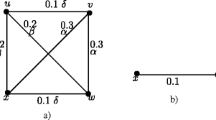Abstract
The real-time availability of data from data servers, often also provided by sensors and measuring devices, as well as the dynamics of phenomena involving complex systems, raise new challenges for researchers. New practices are needed to evaluate and analyze the networks’ structures of underlying structural modeling of their dynamics. In this work, we propose a similarity based on information theory defined on a set of fuzzy graphs so that comparisons can be made. We introduce the Jensen-Shannon divergence measure to compare fuzzy networks. In our approach, this measure is based on fuzzy local probabilities and incorporates networks’ topological characteristics. This approach consists in building a comparison measure using a fuzzy probability distribution as an invariant. This invariant mitigates encoding problems, and the comparison measurement focuses entirely on networks’ topology. In this work, the proposed method is deployed for fuzzy topological navigation networks with energy dissipation in smart building spaces. The proposed modeling of navigation networks in intelligent buildings can be integrated into the OGC IndoorGML standard. It can also still be used for other types of networks.
Access this chapter
Tax calculation will be finalised at checkout
Purchases are for personal use only
Similar content being viewed by others
References
Benavente-Peces, C.: On the energy efficiency in the next generation of smart buildings—supporting technologies and techniques. Energies 12, 4399 (2019). https://doi.org/10.3390/en12224399
Boulmakoul, A.: Generalized path-finding algorithms on semirings and the fuzzy shortest path problem. J. Comput. Appl. Math. 162(1), 263–272 (2004). ISSN 0377–0427
Cecílio, J., Duarte, K., Martins, P., Furtado, P.: RobustPathFinder: handling uncertainty in indoor positioning techniques. Proc. Comput. Sci. 130, 408–415 (2018). ISSN 1877–0509
Dehmer, M., Emmert-Streib, F.: Interrelations of graph distance measures based on topological indices. PLoS ONE 9(4), e94985 (2014). https://doi.org/10.1371/journal.pone.0094985
Donnat, C., Holmes, S.: Tracking network dynamics: a survey of distances and similarity metrics, arXiv:1801.07351 [stat.AP] (2018)
Kang, H.K., Li, K.: A Standard indoor spatial data model- OGC IndoorGML and implementation approaches. ISPRS Int. J. Geo Inf. 6(4), 1–25 (2017)
Jin, M., Jia, R., Spanos, C.J.: Virtual occupancy sensing: using smart meters to indicate your presence. IEEE Trans. Mob. Comput. 2017(16), 3264–3277 (2017)
Kontarinis, A., Zeitouni, K., Marinica, C., Vodislav, D., Kotzinos, D.: Towards a semantic indoor trajectory model. In: The Workshop Proceedingsof the EDBT/ICDT 2019 Joint Conference (March 26, 2019, Lisbon, Portugal) on CEUR-WS.org (2019). https://hal.archives-ouvertes.fr/hal-02314572/document
Lee, W., Krumm, J.: Trajectory preprocessing. In: Computing with Spatial Trajectories, Zheng, Y., Zhou, X., eds., Springer, Bucher, pp. 3–34 (2011)
Li, K., Conti, G., Konstantinidis, E., Zlatanova, S., & Bamidis, P.: OGC IndoorGML: a standard approach for indoor maps. geographical and fingerprinting data to create systems for indoor positioning and indoor/outdoor navigation, pp. 187–207 (2019). https://doi.org/10.1016/b978-0-12-813189-3.00010-1
Markechová, D.: Kullback-Leibler Divergence and mutual information of experiments in the fuzzy case. Axioms 6, 5 (2017). https://doi.org/10.3390/axioms6010005
Noureddine, H.;Ray, C., and Claramunt, C.: Semantic trajectory modelling in indoor and outdoor spaces. In: 21st IEEE International Conference on Mobile Data Management (MDM), pp. 131–136 (2020)
OGC.: OGC IndoorGML, Document No. 14–005r4, 2014. http://www.opengeospatial.org/standards/indoorgml. Accessed 02 Jan 2020
Pang, Y., Zhou, L., Lin, B., Lv, G., Zhang, C.: Generation of navigation networks for corridor spaces based on indoor visibility map. Int. J. Geogr. Inf. Sci. 34(1), 177–201 (2020)
Wang, G., Xu, Y., Qin, S.: Basic fuzzy event space and probability distribution of probability fuzzy space. Mathematics 7, 542 (2019). https://doi.org/10.3390/math7060542
Zadeh, L.A.: Probability measures of fuzzy events. J. Math. Anal. Appl. 23, 421–427 (1968)
Zhang, Q., Li, M., Deng, Y.: Measure the structure similarity of nodes in complex networks based on relative entropy. Phys. Stat. Mech. Appl. 491, 749–763 (2018). ISSN 0378–4371
Zimmermann, H.: Fuzzy set theory and its applications. Springer Science and Business Media (2001). ISBN 978–94–010–3870–6
Author information
Authors and Affiliations
Editor information
Editors and Affiliations
Rights and permissions
Copyright information
© 2022 The Author(s), under exclusive license to Springer Nature Switzerland AG
About this paper
Cite this paper
Boulmakoul, A., Daissaoui, A., Karim, L., Lbath, A. (2022). Jensen-Shannon Divergence for Smart Buildings’ Fuzzy Topological Networks Similarity Analytics. In: Kahraman, C., Cebi, S., Cevik Onar, S., Oztaysi, B., Tolga, A.C., Sari, I.U. (eds) Intelligent and Fuzzy Techniques for Emerging Conditions and Digital Transformation. INFUS 2021. Lecture Notes in Networks and Systems, vol 307. Springer, Cham. https://doi.org/10.1007/978-3-030-85626-7_31
Download citation
DOI: https://doi.org/10.1007/978-3-030-85626-7_31
Published:
Publisher Name: Springer, Cham
Print ISBN: 978-3-030-85625-0
Online ISBN: 978-3-030-85626-7
eBook Packages: Intelligent Technologies and RoboticsIntelligent Technologies and Robotics (R0)




